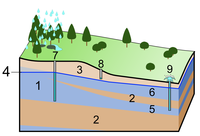
Photo from wikipedia
There is a pressing need for new exploration tools to target and vector towards mineralization in covered terrains. Groundwater provides a valuable and under-utilized geochemical sampling medium, and represents an… Click to show full abstract
There is a pressing need for new exploration tools to target and vector towards mineralization in covered terrains. Groundwater provides a valuable and under-utilized geochemical sampling medium, and represents an important and cost-effective tool to expose covered terrains to systematic exploration. For Au exploration, researchers agree the best hydrogeochemistry pathfinder is dissolved Au itself, with additional potential from other pathfinders (albeit non-unique) such as As, Ag, W and Mo. Despite Au's relatively low solubility, with rigorous field protocols and appropriate analytical methods, explorers can respond to dissolved Au directly with robust parts per trillion (ppt)-level analyses. Even with ppt-level analyses, a practical implication of Au's low solubility is that a deposit's dissolved Au signature is generally weaker than seen in other more mobile pathfinders, producing a smaller detectable footprint, which must be considered when designing exploration programmes. Using purpose-drilled groundwater sampling bores, explorers can collect groundwater samples at the density required to respond to dissolved Au where existing borehole coverage is otherwise insufficient. In addition to its use at the regional scale, with even tighter sample density, hydrogeochemistry also shows promise at the project scale, allowing the 3D modelling of pathfinder dispersion. For hydrogeochemistry to be widely adopted for Au exploration, explorers need confidence in ppt-level dissolved Au analyses, and the context to understand their significance. This paper aims to address these topics and provide a straightforward starting point for Au explorers interested in applying hydrogeochemistry by: (i) summarizing examples of regional sampling programmes and more focused case studies to illustrate how covered Au deposits create measurable dissolved Au footprints distinguishable from background; and (ii) sharing examples of dissolved Au analyses that are being integrated into exploration at the regional and project scales. As seen in the results, the distributions of dissolved Au in the regional- and project-scale programmes show remarkably similar and easy to interpret high-contrast, low-frequency anomalies against relatively low backgrounds. These are desirable attributes of any geochemical pathfinder. When combined with the benefits of hydrogeochemistry v. other geochemical exploration tools (e.g. groundwater can create larger footprints requiring fewer samples to detect, and groundwater can recharge from depth to reflect deeper mineralization), dissolved Au is a powerful pathfinder ideally suited for Au exploration in covered terrains. While this paper focuses on the use of dissolved Au, additional pathfinders can provide valuable information, including indications of lithological changes, hydrothermal alteration and different styles of mineralization, as well as opportunities to use secondary pathfinders when sample density or local conditions may not result in detectable dissolved Au signatures. Thematic collection: This article is part of the Exploration 17 collection available at: https://www.lyellcollection.org/cc/exploration-17
Journal Title: Geochemistry: Exploration, Environment, Analysis
Year Published: 2019
Link to full text (if available)
Share on Social Media: Sign Up to like & get
recommendations!